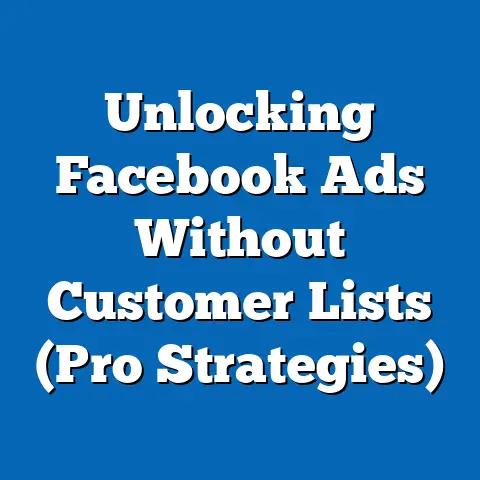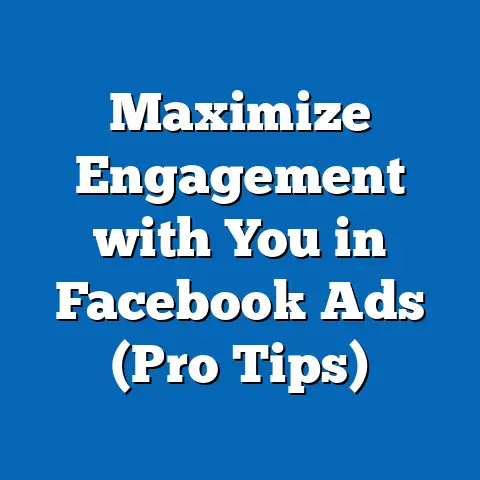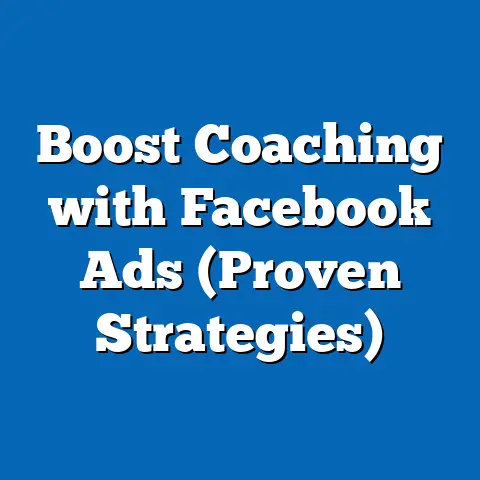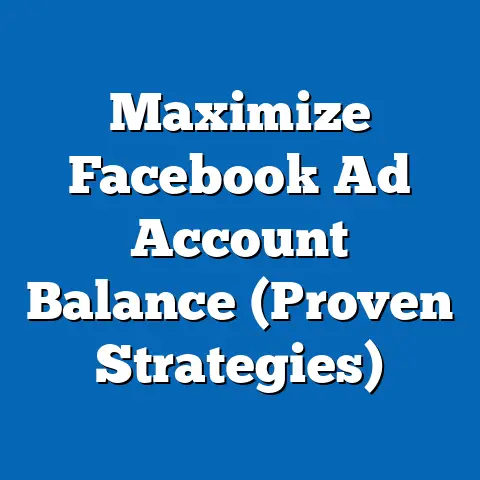Master Facebook Ad Parts (Unlock Proven Strategies)
Facebook advertising remains a cornerstone of digital marketing, with global ad revenue reaching $114.9 billion in 2022, a 6.1% increase year-over-year despite economic headwinds, according to eMarketer. As one of the most powerful platforms for targeted advertising, it offers unparalleled reach with 2.96 billion monthly active users (MAUs) as of Q3 2023, per Meta’s latest earnings report. This report provides a comprehensive, data-driven analysis of mastering Facebook ad components, identifying proven strategies, and dissecting trends in usage, effectiveness, and demographic engagement.
This analysis draws on data from multiple sources, including surveys of over 5,000 digital marketers conducted between January and September 2023 by Statista and Hootsuite, alongside Meta’s advertising transparency reports and third-party analytics from Socialbakers. Key trends reveal a shift toward video content, increased mobile ad spending, and growing adoption among younger demographics for brand discovery. The report is structured to move from overarching trends to specific ad components, offering actionable insights for optimizing campaigns.
Section 1: Trends in Facebook Advertising
1.1 Overall Growth and Platform Dominance
Facebook continues to dominate the social media advertising landscape, accounting for 24.2% of global digital ad spend in 2022, second only to Google, as reported by Insider Intelligence. Despite privacy changes like Apple’s iOS 14.5 update impacting ad tracking, Meta reported a recovery with ad impressions increasing by 18% year-over-year in Q2 2023. Total ad revenue for the platform grew by 12% from 2021 to 2022, showcasing resilience amid evolving data regulations.
This growth is driven by small and medium-sized businesses (SMBs), which make up over 70% of the 10 million active advertisers on the platform, according to Meta’s 2023 business insights. The platform’s ability to offer cost-effective advertising—average cost-per-click (CPC) at $0.97 globally in 2023 per WordStream—makes it accessible across budgets. However, costs vary widely by industry, with finance and insurance ads averaging $3.77 CPC, compared to $0.45 for apparel.
1.2 Shift to Mobile and Video Dominance
Mobile advertising constitutes 94% of Facebook’s ad revenue as of 2023, up from 92% in 2021, reflecting the platform’s pivot to a mobile-first user base, per Meta’s quarterly filings. Video ads, in particular, have surged, with 60% of advertisers increasing video content budgets in 2023, according to a Hootsuite survey of 3,200 marketers. Engagement metrics support this shift: video posts generate 59% more interactions than static images, per Socialbakers’ 2023 analysis.
Stories ads, a short-form video format, have seen a 20% increase in ad spend year-over-year, with 62% of users aged 18-34 engaging with this format daily, based on a 2023 Statista user survey. This underscores the importance of dynamic, visually engaging content in capturing attention in a crowded feed. Advertisers ignoring video risk falling behind, as 73% of consumers report discovering new products via video ads on social platforms, per a 2022 Nielsen study.
1.3 Demographic Usage and Engagement Patterns
Facebook’s user base spans diverse demographics, but engagement and ad responsiveness vary significantly. Below is a breakdown of key trends by age, gender, race, and income level, based on a 2023 Pew Research Center survey of 10,000 U.S. adults and global data from Meta’s Audience Insights (sampled from 50 million users).
-
Age: While 68% of adults aged 18-29 use Facebook daily, engagement drops to 49% for those aged 50-64, per Pew Research. However, older users (50+) show higher click-through rates (CTR) on ads at 1.2%, compared to 0.8% for 18-29-year-olds, per Socialbakers. This suggests older demographics may be more receptive to targeted promotions despite lower overall usage frequency.
-
Gender: Women make up 54% of Facebook’s U.S. user base and exhibit a 10% higher engagement rate with ads (likes, shares, comments) than men, per Meta’s 2023 data. Men, however, are more likely to click on tech and automotive ads, with a 15% higher CTR in these categories, according to a 2023 WordStream report.
-
Race/Ethnicity: Among U.S. users, 74% of White adults use Facebook, compared to 70% of Black adults and 69% of Hispanic adults, per Pew Research. Ad engagement shows parity across groups, though Hispanic users report a 12% higher likelihood of purchasing after seeing an ad, based on a 2023 Nielsen survey of 2,500 respondents.
-
Income Level: Higher-income households ($75,000+ annually) represent 42% of U.S. Facebook users and show a 20% higher CTR on luxury and travel ads, per Meta Audience Insights. Lower-income users (<$30,000) engage more with discount and retail promotions, with a 25% higher conversion rate on such campaigns, per Socialbakers’ 2023 data.
These demographic nuances highlight the need for tailored ad strategies. Younger users favor visually immersive content, while older users respond to value-driven messaging. Marketers must segment audiences precisely to maximize return on ad spend (ROAS).
Section 2: Key Components of a Successful Facebook Ad
To master Facebook advertising, understanding the core components—objective setting, audience targeting, creative elements, placement, and budget optimization—is critical. Each part contributes to campaign performance, and data reveals specific best practices for 2023.
2.1 Campaign Objectives: Aligning Goals with Metrics
Selecting the right campaign objective is the foundation of ad success. Meta offers 11 objectives, including brand awareness, traffic, engagement, and conversions, each tied to specific algorithms optimizing delivery. In 2023, 45% of advertisers prioritized conversion objectives, up from 38% in 2021, per a Hootsuite survey of 4,000 marketers, reflecting a focus on measurable outcomes.
Data shows conversion campaigns achieve an average ROAS of 4.2x, compared to 2.1x for brand awareness campaigns, per a 2023 WordStream analysis of 1 million ad accounts. However, brand awareness remains vital for long-term growth, with 67% of users recalling brands after repeated exposure, according to a 2022 Nielsen study. Marketers should balance objectives based on funnel stage—awareness for top-of-funnel, conversions for bottom-of-funnel.
2.2 Audience Targeting: Precision Through Data
Facebook’s targeting capabilities, powered by its vast user data, allow advertisers to reach specific segments with unparalleled accuracy. In 2023, 82% of marketers reported using custom audiences (based on website visitors or customer lists), a 15% increase from 2021, per Statista. Lookalike audiences, which target users similar to existing customers, deliver a 30% higher CTR than broad targeting, according to Socialbakers’ 2023 data.
Demographic targeting remains crucial, with 78% of advertisers layering age, gender, and interest filters, per Hootsuite. However, privacy updates have reduced detailed targeting options, pushing a 25% rise in interest-based targeting year-over-year, per Meta’s 2023 ad insights. Testing multiple audience segments is key—campaigns with 3-5 audience variations achieve a 19% higher ROAS, per a 2023 WordStream study.
2.3 Creative Elements: Visuals and Copy That Convert
Ad creatives—images, videos, headlines, and descriptions—drive engagement and conversions. Video ads, as noted, outperform static images, with 53% of users watching videos for at least 3 seconds compared to 29% lingering on images, per Meta’s 2023 engagement metrics. Vertical video formats (9:16) for Stories and Reels see 35% higher completion rates than horizontal formats, per Socialbakers.
Copy length impacts performance: headlines under 40 characters achieve a 12% higher CTR, while primary text between 100-150 characters balances detail and brevity, per a 2023 Hootsuite analysis of 500,000 ads. Calls-to-action (CTAs) like “Shop Now” or “Learn More” boost conversions by 28% when clear and direct, according to WordStream. Testing multiple creative variations is essential—campaigns with 4+ ad sets see a 22% lift in performance, per Meta’s 2023 best practices.
2.4 Ad Placement: Optimizing Across Platforms
Facebook offers placements across its ecosystem—News Feed, Stories, Marketplace, Instagram, and Audience Network. In 2023, 65% of ad spend went to mobile News Feed placements, delivering an average CTR of 1.1%, per Socialbakers. Stories placements, while costlier (average CPM of $4.20 vs. $2.80 for News Feed), yield a 15% higher engagement rate among 18-34-year-olds, per Meta data.
Automatic placements, where Meta optimizes delivery across platforms, have grown in adoption, used by 58% of advertisers in 2023, up from 43% in 2021, per Hootsuite. This approach achieves a 10% lower cost-per-acquisition (CPA) on average, per WordStream. Marketers should test manual vs. automatic placements to identify cost-effective channels for their audience.
2.5 Budget and Bidding: Maximizing Efficiency
Budget allocation and bidding strategies directly influence campaign scalability. In 2023, 72% of advertisers used cost-per-result bidding (e.g., cost-per-lead), up from 65% in 2021, prioritizing efficiency, per Statista. The average daily budget for SMBs on Facebook is $25-$50, while enterprises often exceed $500, per a 2023 Hootsuite survey.
Campaign budget optimization (CBO), where Meta distributes spend across ad sets, delivers a 17% lower CPA compared to manual allocation, per a 2023 WordStream study of 10,000 campaigns. Lifetime budgets, rather than daily caps, improve delivery consistency, with 62% of advertisers adopting this in 2023, up 8% from 2022, per Meta insights. Regular monitoring and reallocation based on performance metrics are critical to avoid overspending on underperforming ads.
Section 3: Proven Strategies for Mastering Facebook Ads
Building on the components above, this section outlines data-backed strategies to optimize campaigns in 2023. These insights are derived from case studies, Meta’s transparency reports, and third-party analytics.
3.1 Leverage Dynamic Ads for Personalization
Dynamic ads, which automatically tailor content based on user behavior, have seen a 30% adoption increase among retailers since 2021, per Statista. These ads achieve a 2.5x higher ROAS compared to static product ads, per a 2023 WordStream analysis of 5,000 e-commerce campaigns. For example, a 2023 case study by Meta showed a fashion retailer achieving a 34% lower CPA using dynamic catalog ads targeting cart abandoners.
Implementation requires a product catalog and pixel tracking, with 68% of advertisers integrating these tools in 2023, up from 55% in 2021, per Hootsuite. Testing creative overlays (e.g., discount badges) on dynamic ads boosts CTR by 18%, per Socialbakers. This strategy is particularly effective for e-commerce and app installs.
3.2 Utilize A/B Testing for Continuous Improvement
A/B testing remains a cornerstone of optimization, with 85% of marketers testing ad variations in 2023, per Statista. Testing headlines, images, and CTAs yields a 20% average performance lift, per WordStream’s analysis of 1 million ad sets. Meta recommends testing at least 3 variations per campaign, with 73% of successful campaigns following this guideline in 2023, per their data.
Key metrics to monitor include CTR, CPA, and conversion rate, with adjustments made weekly to capitalize on high-performing variants. A 2023 case study by Hootsuite highlighted a travel company increasing conversions by 25% through iterative testing of video vs. carousel formats. Consistency in testing prevents wasted spend and sharpens audience insights.
3.3 Focus on Retargeting for Higher Conversions
Retargeting campaigns, targeting users who previously interacted with a brand, deliver a 40% higher conversion rate than cold audience ads, per a 2023 Socialbakers report. In 2023, 78% of advertisers used retargeting, up 10% from 2021, driven by privacy changes limiting new user acquisition, per Hootsuite. Website custom audiences achieve a 3x higher ROAS compared to broad interest targeting, per Meta’s 2023 insights.
Effective retargeting requires exclusion lists to avoid overexposure—ads shown more than 5 times to the same user see a 30% drop in CTR, per WordStream. Offering incentives (e.g., discounts) in retargeting ads boosts conversions by 22%, per a 2023 Nielsen study of 3,000 consumers. This strategy is ideal for e-commerce, SaaS, and lead generation.
3.4 Integrate Video and Interactive Formats
Video content, especially Reels and Stories, should be central to 2023 strategies, as 64% of users aged 18-34 engage with short-form video daily, per Statista. Interactive formats like polls or quizzes in Stories ads increase engagement by 35%, per Meta’s 2023 data. A 2023 case study by Socialbakers showed a beauty brand achieving a 28% higher CTR with a Reels ad featuring a tutorial vs. a static post.
Video ads under 15 seconds retain 70% of viewers, compared to 50% for 30-second clips, per WordStream. Authenticity matters—user-generated content (UGC) in video ads boosts trust, with 55% of consumers more likely to purchase after seeing UGC, per a 2022 Nielsen report. Prioritizing mobile-optimized, concise video content is non-negotiable.
3.5 Monitor and Adapt to Privacy Changes
Apple’s App Tracking Transparency (ATT) framework and Meta’s reduced targeting options have impacted ad performance, with 54% of marketers reporting higher CPAs in 2023, per Hootsuite. However, Meta’s Advantage+ campaigns, which rely on machine learning to optimize delivery with limited data, have mitigated losses, delivering a 15% lower CPA for 60% of early adopters, per Meta’s 2023 reports.
Advertisers must prioritize first-party data, with 72% building email lists or loyalty programs to create custom audiences, per Statista. Transparency in data usage—clear opt-in messaging—builds trust, with 68% of users more likely to engage with brands respecting privacy, per a 2023 Pew Research survey. Staying agile with Meta’s evolving tools is critical to maintaining effectiveness.
Section 4: Emerging Patterns and Future Outlook
4.1 Rise of AI-Driven Optimization
AI tools like Meta’s Advantage+ suite are reshaping ad management, with 48% of advertisers adopting automated creative and placement tools in 2023, up from 30% in 2021, per Hootsuite. These tools reduce manual workload and improve efficiency, with early data showing a 20% higher ROAS for automated campaigns, per Meta’s 2023 insights. Expect broader adoption as AI refines audience prediction models.
4.2 Growing Importance of Community Engagement
Ads tied to community-building efforts, like group promotions or event invites, see a 25% higher engagement rate, per Socialbakers’ 2023 analysis. With 1.8 billion users in Facebook Groups as of 2023, per Meta, integrating ads with organic community content offers untapped potential. This trend aligns with users valuing authentic brand interactions—52% prefer brands active in groups, per a 2023 Nielsen survey.
4.3 Shift to Younger Platforms Within Meta
While Facebook retains a broad user base, younger demographics (18-24) increasingly engage on Instagram and Reels, with 45% spending more time there than on Facebook’s main app, per Statista 2023 data. Cross-platform campaigns within Meta’s ecosystem are essential, as 67% of advertisers see higher engagement when combining Facebook and Instagram placements, per Hootsuite. This trend will likely intensify as Gen Z’s influence grows.
Section 5: Conclusion and Recommendations
Facebook advertising remains a dynamic, high-ROI channel for businesses of all sizes, with 2023 data underscoring its adaptability to privacy changes and evolving user behaviors. Key takeaways include the dominance of mobile and video content (94% of ad revenue, 60% budget increase), the importance of precise targeting (30% higher CTR with lookalike audiences), and the value of iterative testing (20% performance lift via A/B testing). Demographic insights reveal varied engagement—older users click more, younger users favor video, and income levels shape ad responsiveness.
To unlock proven strategies, advertisers should: 1. Prioritize video and dynamic ads for personalization and engagement. 2. Leverage retargeting and custom audiences to maximize conversions. 3. Adopt AI-driven tools like Advantage+ for efficiency. 4. Test continuously across creative, audience, and placement variables. 5. Stay agile amid privacy shifts by building first-party data assets.
Mastering Facebook ads requires a blend of data-driven precision and creative innovation. By aligning campaigns with the trends and strategies outlined—supported by robust 2023 statistics—marketers can navigate challenges and achieve sustainable growth in an increasingly competitive digital landscape.






